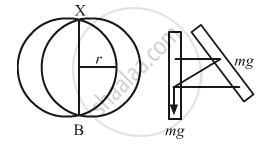Advertisements
Advertisements
Question
A closed circular wire hung on a nail in a wall undergoes small oscillations of amplitude 20 and time period 2 s. Find (a) the radius of the circular wire, (b) the speed of the particle farthest away from the point of suspension as it goes through its mean position, (c) the acceleration of this particle as it goes through its mean position and (d) the acceleration of this particle when it is at an extreme position. Take g = π2 m/s2.
Solution
It is given that:
Time period of oscillation, T = 2 s
Acceleration due to gravity, g =\[\pi^2\]ms−2
Let I be the moment of inertia of the circular wire having mass m and radius r.

(a) Time period of compound pendulum \[\left( T \right)\] is given by ,
\[T = 2\sqrt{\frac{I}{mgl}} = 2\sqrt{\frac{I}{mgr}}\]
\[\left( \because l = r \right)\] ...(1)
Moment of inertia about the point of suspension is calculated as,
I = mr2 + mr2 = 2mr2
On substituting the value of moment of inertia I in equation (1), we get:
\[T = 2\pi\sqrt{\frac{2m r^2}{mgr}} = 2\pi\sqrt{\frac{2r}{g}}\]
\[ \Rightarrow \frac{2}{2\pi} = \sqrt{\frac{2r}{g}}\]
\[ \Rightarrow \frac{2r}{g} = \frac{1}{\pi^2}\]
\[ \Rightarrow r = \frac{g}{2 \pi^2}\]
\[ = 0 . 5 m = 50 cm\]
(b) From the energy equation, we have:
\[\frac{1}{2}I \omega^2 - 0 = mgr \left( 1 - \cos \theta \right)\]
\[\frac{1}{2}I \omega^2 - 0 = mgr \left( 1 - \cos 2^\circ \right)\]
\[\Rightarrow \left( \frac{1}{2} \right)2m r^2 \cdot \omega^2 = mgr\left( 1 - \cos 2^\circ\right) \left( \because I = 2m r^2 \right)\]
\[ \Rightarrow \omega^2 = \frac{g}{r}\left( 1 - \cos 2^\circ\right)\]
\[\text { On substituing the value of g and r in the above equation, we get:}\] \[\omega = 0 . 11 rad/s\]
\[ \Rightarrow v = \omega \times 2r = 11 {\text { cms }}^{- 1}\]
(c) The acceleration is found to be centripetal at the extreme position.
Centripetal acceleration at the extreme position \[\left( a_n \right)\] is given by,
an = ω2(2r) = (0.11) × 100 = 12 cm/s2
The direction of an is towards the point of suspension.
(d) The particle has zero centripetal acceleration at the extreme position. However, the particle will still have acceleration due to the S.H.M.
Angular frequency \[\left( \omega \right)\] is given by ,
\[\omega = \frac{2\pi}{T}\]
\[ = \frac{2\pi}{2} = 3 . 14\]
\[\therefore\] Angular Accelaration \[\left( a \right)\] at the extrame position is given as ,
\[\alpha = \omega^2 \theta\]
\[\alpha = \omega^2 2^\circ= \pi^2 \times \frac{2\pi}{180}\]
\[ = \frac{2 \pi^3}{180} \left[ 1^\circ= \frac{\pi}{180}\text { radian } \right]\]
Thus , tangential acceleration
\[= \alpha\left( 2r \right) = \left( \frac{2 \pi^3}{180} \right) \times 100\]
= 34 cm/s2
APPEARS IN
RELATED QUESTIONS
Define phase of S.H.M.
State the differential equation of linear simple harmonic motion.
A particle executing simple harmonic motion comes to rest at the extreme positions. Is the resultant force on the particle zero at these positions according to Newton's first law?
Can simple harmonic motion take place in a non-inertial frame? If yes, should the ratio of the force applied with the displacement be constant?
A small creature moves with constant speed in a vertical circle on a bright day. Does its shadow formed by the sun on a horizontal plane move in a sample harmonic motion?
The time period of a particle in simple harmonic motion is equal to the smallest time between the particle acquiring a particular velocity \[\vec{v}\] . The value of v is
The motion of a particle is given by x = A sin ωt + B cos ωt. The motion of the particle is
An object is released from rest. The time it takes to fall through a distance h and the speed of the object as it falls through this distance are measured with a pendulum clock. The entire apparatus is taken on the moon and the experiment is repeated
(a) the measured times are same
(b) the measured speeds are same
(c) the actual times in the fall are equal
(d) the actual speeds are equal
The pendulum of a certain clock has time period 2.04 s. How fast or slow does the clock run during 24 hours?
Assume that a tunnel is dug across the earth (radius = R) passing through its centre. Find the time a particle takes to cover the length of the tunnel if (a) it is projected into the tunnel with a speed of \[\sqrt{gR}\] (b) it is released from a height R above the tunnel (c) it is thrown vertically upward along the length of tunnel with a speed of \[\sqrt{gR}\]
A simple pendulum fixed in a car has a time period of 4 seconds when the car is moving uniformly on a horizontal road. When the accelerator is pressed, the time period changes to 3.99 seconds. Making an approximate analysis, find the acceleration of the car.
A particle is subjected to two simple harmonic motions, one along the X-axis and the other on a line making an angle of 45° with the X-axis. The two motions are given by x = x0 sin ωt and s = s0 sin ωt. Find the amplitude of the resultant motion.
In a simple harmonic oscillation, the acceleration against displacement for one complete oscillation will be __________.
A simple pendulum is suspended from the roof of a school bus which moves in a horizontal direction with an acceleration a, then the time period is
Define the frequency of simple harmonic motion.
Consider a simple pendulum of length l = 0.9 m which is properly placed on a trolley rolling down on a inclined plane which is at θ = 45° with the horizontal. Assuming that the inclined plane is frictionless, calculate the time period of oscillation of the simple pendulum.
The displacement of a particle varies with time according to the relation y = a sin ωt + b cos ωt.
What is the ratio of maxmimum acceleration to the maximum velocity of a simple harmonic oscillator?
A body having specific charge 8 µC/g is resting on a frictionless plane at a distance 10 cm from the wall (as shown in the figure). It starts moving towards the wall when a uniform electric field of 100 V/m is applied horizontally toward the wall. If the collision of the body with the wall is perfectly elastic, then the time period of the motion will be ______ s.

